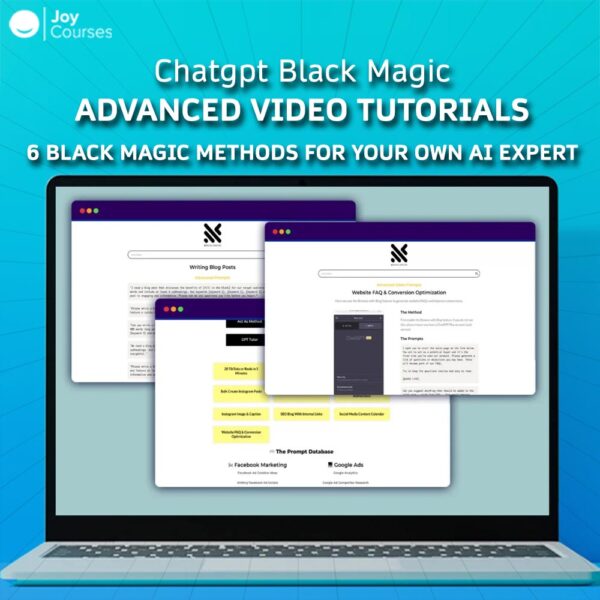Description
Chatgpt Black Magic Advanced Video Tutorials, 6 Black Magic Methods for Your own AI Expert
![]()
ChatGPT Black Magic Advanced Video Tutorials: 6 Black Magic Methods for Your Own AI Expert
The concept of “Black Magic” in the context of AI and ChatGPT refers to advanced, often hidden or less obvious techniques for extracting the best results from AI models like ChatGPT. Here, I’ll outline six advanced methods or “Black Magic” strategies you can use to optimize how you work with AI, especially when leveraging ChatGPT for high-level tasks in various fields.
1. Multi-Layer Prompt Engineering (Advanced Prompt Stacking)
What It Is: This technique involves layering multiple instructions in a single interaction to guide the AI through increasingly complex tasks. By feeding prompts in sequential stages, you enable ChatGPT to process each step methodically before tackling the next, ensuring more refined and higher-quality output.
How to Use It:
- Initial Prompt: Start with a general inquiry to get an overview. Example: “Tell me the steps to run a successful Facebook Ads campaign.”
- Refinement Prompt: Ask ChatGPT to expand on one specific step in detail. Example: “Explain how to target the right audience for this campaign.”
- Detail-Level Prompt: Finally, request even more precise, data-driven suggestions. Example: “List tools that can help refine the targeting for this audience.”
Why It Works: By breaking down the complexity into layers, you avoid overwhelming the model, and it responds with more specific, actionable insights.
2. Memory-Context Looping (MCL)
What It Is: Since ChatGPT cannot retain memory over time, using a technique known as “Memory-Context Looping” helps mimic memory by constantly re-feeding past interactions to ensure ChatGPT builds on what was previously discussed.
How to Use It:
- Summarize what ChatGPT provided before and include it in each new prompt. This method builds the illusion of ongoing memory, allowing you to sustain context over multiple exchanges.
Example:
1st Prompt: “Give me an SEO strategy for a local restaurant.”
2nd Prompt: “Based on the SEO strategy we just discussed, expand on local keyword research.”
3rd Prompt: “Can you help me create content ideas using the SEO strategy and keyword research?”
Why It Works: Since ChatGPT doesn’t have native memory between sessions, this looping technique mimics memory, enabling richer conversations across multiple prompts.
3. Role-Play Methodology
What It Is: Role-play with ChatGPT can enhance your interactions. By assigning it specific roles, such as a digital marketing strategist, UX designer, or sales expert, you condition the AI to provide more domain-specific responses.
How to Use It:
- Example Role Prompt: “You are a seasoned financial advisor with expertise in cryptocurrency investments. Based on your knowledge, what are the top 3 risks when investing in new coins?”
- Follow-Up Role Prompt: “Now, imagine you are an economist. How would you critique the risks of cryptocurrency based on traditional financial principles?”
Why It Works: Assigning roles helps the AI focus on a more specific set of knowledge relevant to the field, delivering targeted and refined answers.
4. Pattern Recognition & Reverse Engineering
What It Is: This method involves identifying patterns in ChatGPT’s output and reversing them to create even more precise and customized answers.
How to Use It:
- Output Pattern Recognition: If you consistently see a pattern, such as ChatGPT providing bulleted lists or certain types of responses, reverse-engineer that pattern to shape future queries.
- Example: If you know that when you ask for “steps” ChatGPT provides more structured answers, use this to your advantage: “List the steps to launch a product on Shopify.”
Why It Works: Understanding how ChatGPT organizes its output helps you predict how to frame your questions for optimal results.
5. AI-Assisted Brainstorming Sessions (Creative Prompt Collaboration)
What It Is: Use ChatGPT as a brainstorming partner by feeding it creative, speculative, or futuristic prompts. This technique is excellent for idea generation, allowing the AI to provide input that might spark innovative solutions or content.
How to Use It:
- Example Creative Prompt: “Let’s brainstorm 10 potential business models for an AI-driven app that helps people manage their daily routines.”
- Follow-Up: “Expand on the top 3 business models by detailing how they would work and generate revenue.”
Why It Works: ChatGPT’s wide knowledge base can surface diverse, out-of-the-box ideas you might not have considered.
6. Turbocharging Outputs Using Constraints
What It Is: Introducing constraints in your prompts forces the AI to deliver more focused and highly detailed responses. Limiting word counts, focusing on specific numbers or narrowing the scope of information can push ChatGPT to be more precise.
How to Use It:
- Example Constraint Prompt: “Summarize the key steps for developing a lead magnet, but keep it under 100 words.”
- Numerical Constraint Prompt: “List 5 digital marketing tools for small businesses, with a brief 2-sentence description of each.”
Why It Works: Constraints force the AI to prioritize critical information, which results in more succinct, high-quality outputs.
In Summary
These six advanced methods will empower you to extract the most value from ChatGPT, enabling it to function as an expert AI collaborator across various tasks:
- Multi-Layer Prompt Engineering: Build complexity step-by-step for more accurate answers.
- Memory-Context Looping (MCL): Feed context back to the model to simulate memory and continuity.
- Role-Play Methodology: Assign roles to focus ChatGPT’s responses on specific expertise.
- Pattern Recognition & Reverse Engineering: Exploit known patterns in ChatGPT’s outputs to fine-tune your inputs.
- AI-Assisted Brainstorming Sessions: Use ChatGPT for creative collaboration and idea generation.
- Turbocharging Outputs Using Constraints: Add limits to sharpen the clarity and focus of the AI’s responses.
By mastering these techniques, you’ll have the ability to utilize ChatGPT in a more strategic and effective way, bringing out its full potential as your “AI Expert.”













